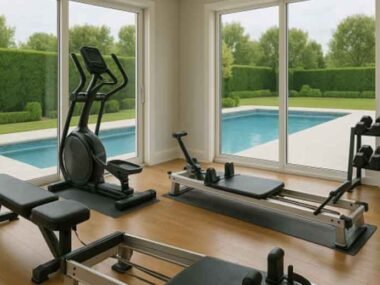Most people obsess over finding the perfect workout program or the right split between cardio and strength training. They’ll research exercises, count macros, and track every rep. But here’s what often gets overlooked: where you work out might be just as important as what you’re actually doing. The environment around you—the space, the energy, the people, even the lighting—shapes your experience in ways that go far beyond just having access to equipment.
Think about it. You can do the same exact workout in a cramped, poorly lit basement or in a bright studio with great music and other people pushing themselves. The exercises are identical, but the experience? Completely different. And that difference shows up in how consistently you go, how hard you push, and whether you actually enjoy the process or just tolerate it.
The Psychology of Space
The physical environment triggers responses before you even start moving. Walk into a space with high ceilings, natural light, and clean equipment, and there’s an immediate psychological shift. The brain registers this as a place where good things happen. It feels intentional, cared for, and energizing.
Compare that to a cluttered gym with flickering fluorescent lights and equipment that’s seen better days. Even if the weights work just fine, the atmosphere drains motivation before the first set. Research on environmental psychology shows that physical surroundings directly impact mood, energy levels, and willingness to engage in challenging tasks. A workout is definitely a challenging task.
The layout matters too. Open spaces with good flow make it easier to move between exercises without feeling cramped or self-conscious. When equipment is organized logically and there’s enough room to breathe, the whole experience feels less overwhelming. This is especially true for people who are already nervous about working out or returning after time off.
Energy Is Contagious (In Both Directions)
Here’s the thing about working out around other people: their energy affects yours whether you realize it or not. In a space where people are genuinely pushing themselves, that effort becomes contagious. You see someone finishing a tough set and it reminds you to give your own workout everything you’ve got. The collective momentum builds on itself.
Group settings create accountability without anyone having to say a word. When everyone around you is showing up and working hard, it becomes the norm. Slacking off feels out of place. For many people, West Hollywood fitness classes provide exactly this kind of atmosphere—spaces designed specifically to amplify that group energy and make showing up feel like joining something bigger than just another workout.
But this works both ways. In an environment where half the people are scrolling their phones between sets or treating the gym like a social hour, that low-effort vibe spreads too. It’s harder to stay focused when the overall energy is flat or distracted.
Sound and Music Make a Bigger Difference Than Expected
The audio environment shapes intensity in ways most people don’t consciously notice until they work out somewhere with really dialed-in sound. Music tempo naturally influences movement speed and effort level. Upbeat, high-energy tracks push people to move faster and work harder. Slower music has the opposite effect.
Beyond just tempo, the quality of the sound system matters. Tinny speakers or barely audible music don’t create atmosphere—they just fade into background noise. Good sound makes you feel like you’re part of something, almost like a performance. It elevates the experience from “doing exercises” to actually training.
Then there’s the absence of music in some environments, which works for certain people but feels flat to others. Some prefer the quiet to focus on form and breathing. Most people, though, need that auditory push to override the internal voice saying to slow down or stop early.
Temperature and Air Quality
This one sneaks up on people. A gym that’s too hot makes every workout feel harder than it needs to be. Overheating kills performance and makes even moderate exercise feel exhausting. On the flip side, a space that’s too cold means spending the first 15 minutes trying to warm up instead of actually working.
Proper ventilation changes everything. Stuffy air makes breathing harder, which limits how much intensity you can maintain. Fresh air circulation keeps oxygen flowing and prevents that gross, sweaty atmosphere from building up. It’s a detail that seems minor until you work out somewhere with terrible airflow—then it becomes impossible to ignore.
The Community Factor
Beyond just the physical space, the culture of a workout environment shapes the entire experience. Some places feel welcoming and supportive from day one. Others have an intimidating vibe where everyone seems to already know what they’re doing, and newcomers feel like they’re intruding.
The best environments strike a balance. People are focused on their own workouts but also encouraging to others. There’s a sense of shared purpose without excessive socializing that gets in the way of actually training. The staff sets the tone here—when trainers and front desk people genuinely care about members, that warmth filters through everything.
Regular faces start becoming familiar. You’re not necessarily becoming best friends with everyone, but there’s a comfort in recognizing people and being recognized. That sense of belonging is powerful. It transforms a workout spot from just a place you go into a community you’re part of.
Making the Switch When Your Current Space Isn’t Working
If workouts consistently feel like a chore and motivation is always low, the environment might be the problem rather than the program. Sometimes it’s worth trying a completely different setting to see if the energy shifts. A change in surroundings can reignite interest that’s been fading.
Pay attention to how a space makes you feel in the first few minutes. Does walking in make you want to get started, or does it feel like an obligation? Does the atmosphere support focus, or is it chaotic and distracting? These gut reactions matter more than the list of equipment or amenities.
The workout environment isn’t everything, but it’s way more than nothing. The right space makes consistency easier, pushes intensity higher, and turns exercise from something to endure into something worth showing up for. Finding that environment might be the difference between sticking with fitness long-term or constantly starting over.










